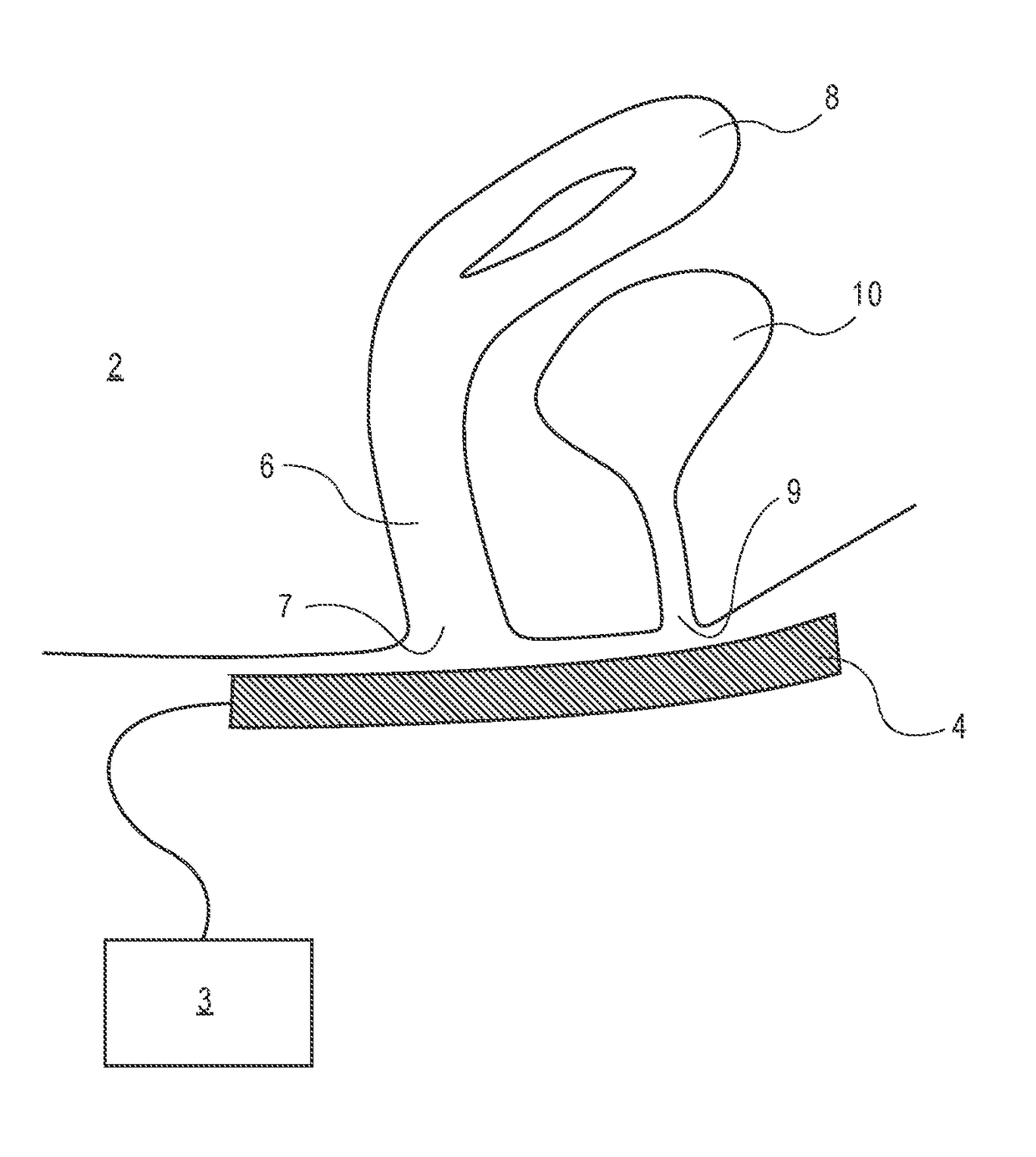Device and method to treat vaginal atrophy
a vaginal atrophy and device technology, applied in the field of vaginal atrophy devices and methods, can solve the problems of diminishing sexual response, no data showing that any prior art device and method provides a lasting benefit, and affecting so as to improve the health of vaginal tissue, effective treatment of vaginal atrophy, and increase the effect of vaginal blood flow
- Summary
- Abstract
- Description
- Claims
- Application Information
AI Technical Summary
Benefits of technology
Problems solved by technology
Method used
Image
Examples
example 1
[0055]In a controlled study, the legs of two female subjects were placed in stirrups, and a baseline measurement of the blood pulse amplitude of the subjects' internal vaginal wall was measured with a vaginal plethysmography probe for two minutes. The beat average of the raw signals from the probes for the two subjects are plotted on FIGS. 7 and 8 as the first bar at each of times 0, 0.5 min, 1 minute and 2 minutes. A speculum exam was then performed on the subjects, and the plethysmography probe was once again used to measure the blood pulse amplitude in the subjects' vaginal tissue for two minutes (not shown in FIGS. 7 and 8). Thereafter, a condom filled with warm water and coated on both sides with a sonolucent gel was placed on each subject's vaginal area to cover her vulva and introitus, and an ultrasound transducer was placed against the condom. Ultrasound energy was introduced via the ultrasound transducer at 1 MHz, 1.5 W / cm2 intensity, 50% duty cycle for 8 minutes. After the...
example 2
[0056]As in Example 1, the legs of a female subject were placed in stirrups, and a baseline measurement of the blood pulse amplitude of the subject's internal vaginal wall was measured with a vaginal plethysmography probe for two minutes. The beat average of the raw signal from the probe is plotted on FIG. 9 as the first bar at each of times 0, 0.5 min, 1 minute and 2 minutes. A speculum exam was then performed on the subject, and the plethysmography probe was once again used to measure the blood pulse amplitude in the subject's vaginal tissue for two minutes (not shown in FIG. 9). Thereafter, a condom filled with warm water and coated on both sides with a sonolucent gel was placed on the subject's vaginal area to cover her vulva and introitus, and an ultrasound transducer was placed against the condom. Ultrasound energy was introduced via the ultrasound transducer at 1 MHz, 1.5 W / cm2 intensity, 50% duty cycle for 8 minutes. After the 8 minute treatment, the ultrasound transducer an...
example 3
[0057]As in Examples 1 and 2, the legs of a female subject were placed in stirrups, and a baseline measurement of the blood pulse amplitude of the subject's internal vaginal wall was measured with a vaginal plethysmography probe for two minutes. A speculum exam was then performed on the subject, and the plethysmography probe was once again used to measure the blood pulse amplitude in the subject's vaginal tissue for two minutes (not shown in FIG. 10). The beat average of the raw signal from the probe after the speculum exam is plotted on FIG. 10 as the first bar at each of times 0, 0.5 min, 1 minute and 2 minutes. Thereafter, a condom filled with warm water and coated on both sides with a sonolucent gel was placed on each subject's vaginal area to cover her vulva and introitus, and an ultrasound transducer was placed against the condom. Ultrasound energy was introduced via the ultrasound transducer at 1 MHz, 1.5 W / cm2 intensity, 50% duty cycle for 8 minutes. After the 8 minute treat...
PUM
 Login to View More
Login to View More Abstract
Description
Claims
Application Information
 Login to View More
Login to View More - R&D
- Intellectual Property
- Life Sciences
- Materials
- Tech Scout
- Unparalleled Data Quality
- Higher Quality Content
- 60% Fewer Hallucinations
Browse by: Latest US Patents, China's latest patents, Technical Efficacy Thesaurus, Application Domain, Technology Topic, Popular Technical Reports.
© 2025 PatSnap. All rights reserved.Legal|Privacy policy|Modern Slavery Act Transparency Statement|Sitemap|About US| Contact US: help@patsnap.com



